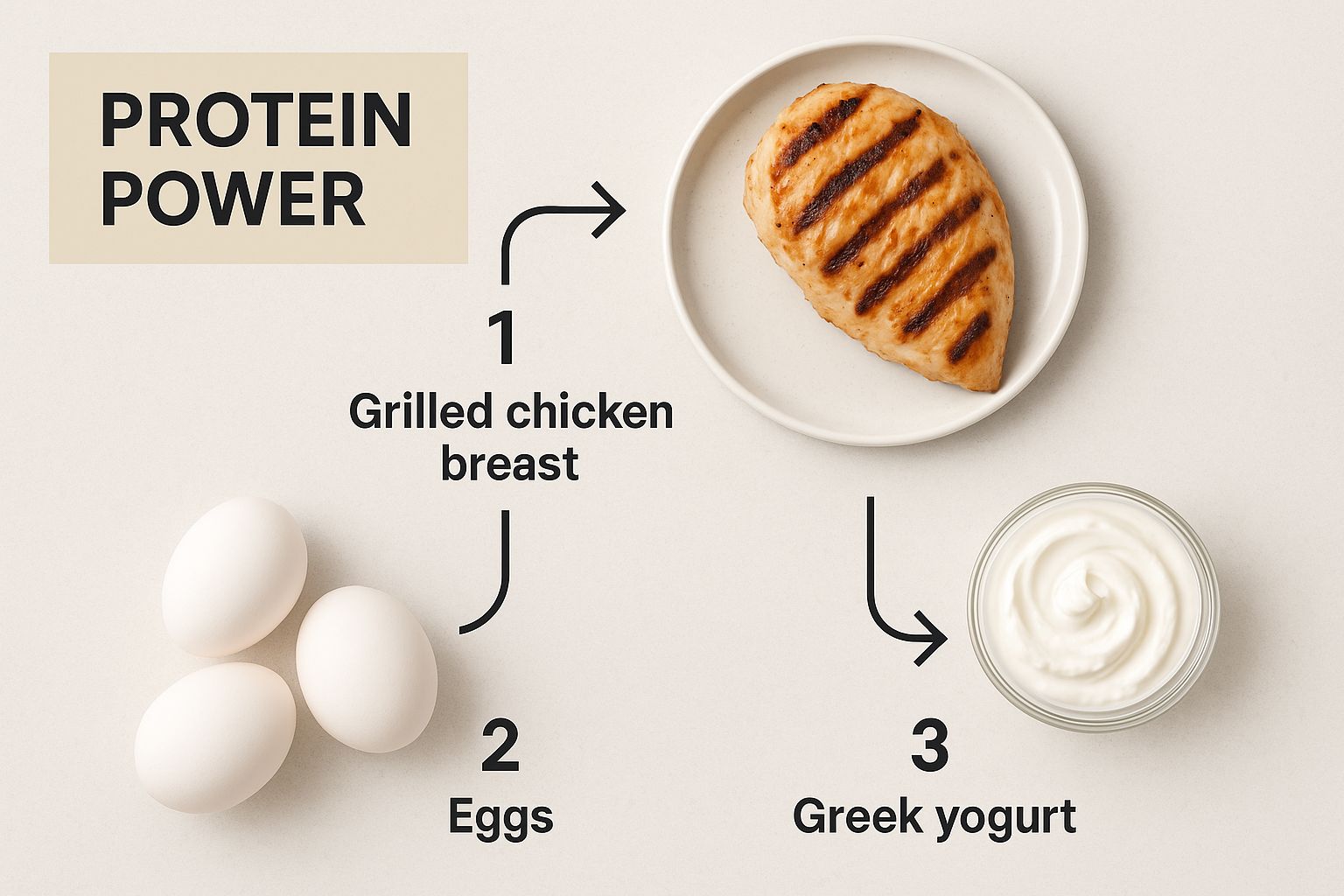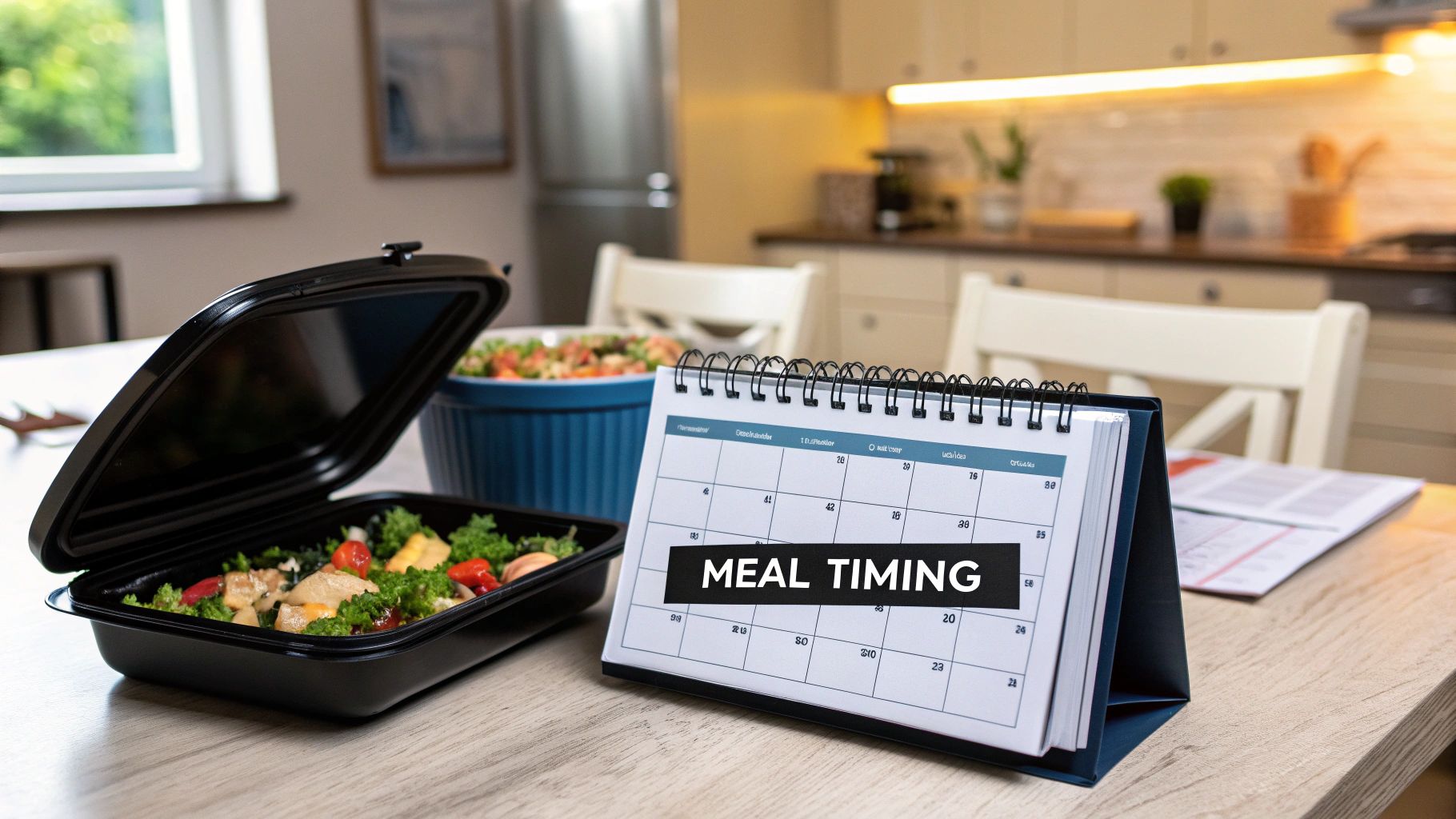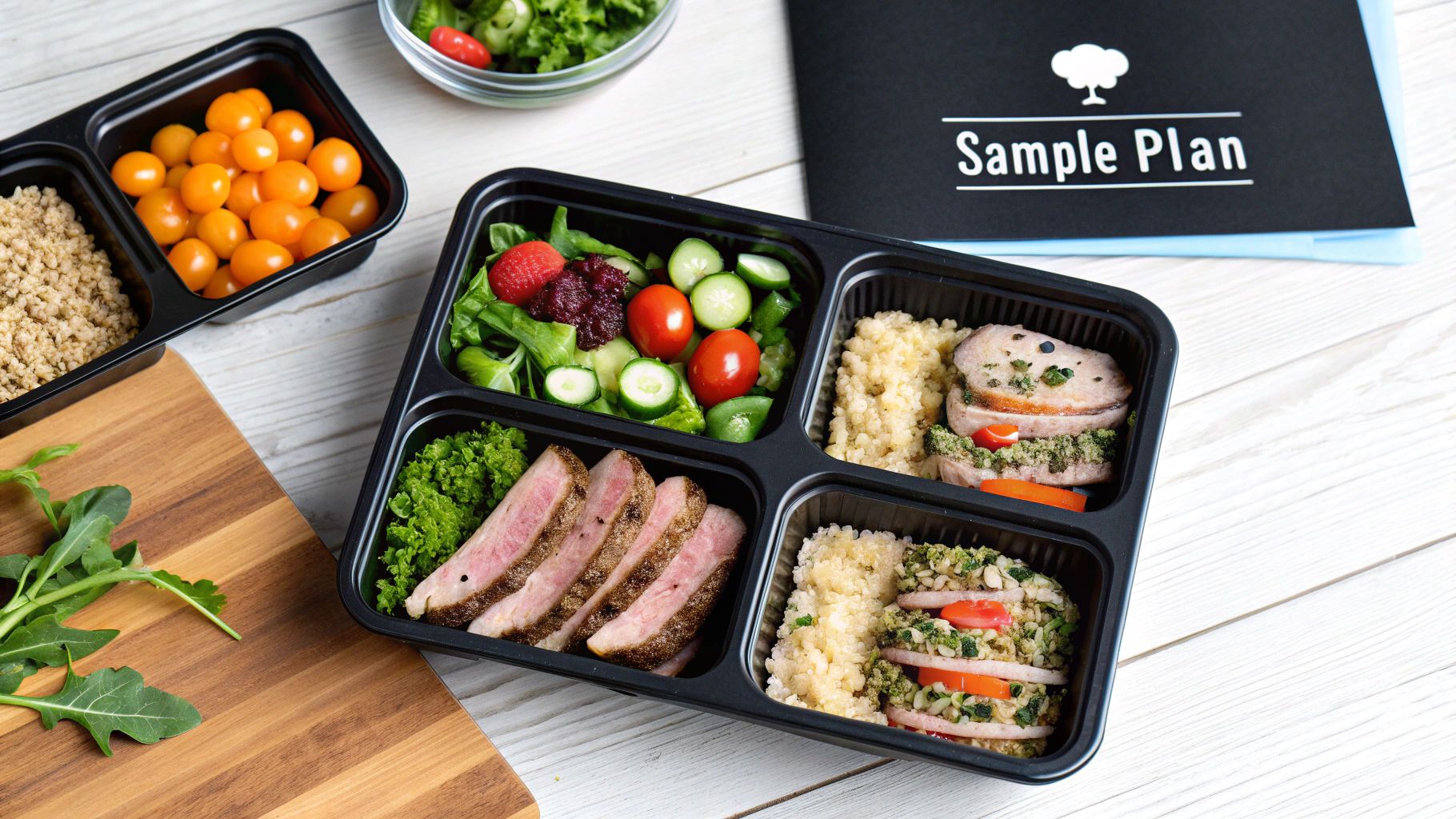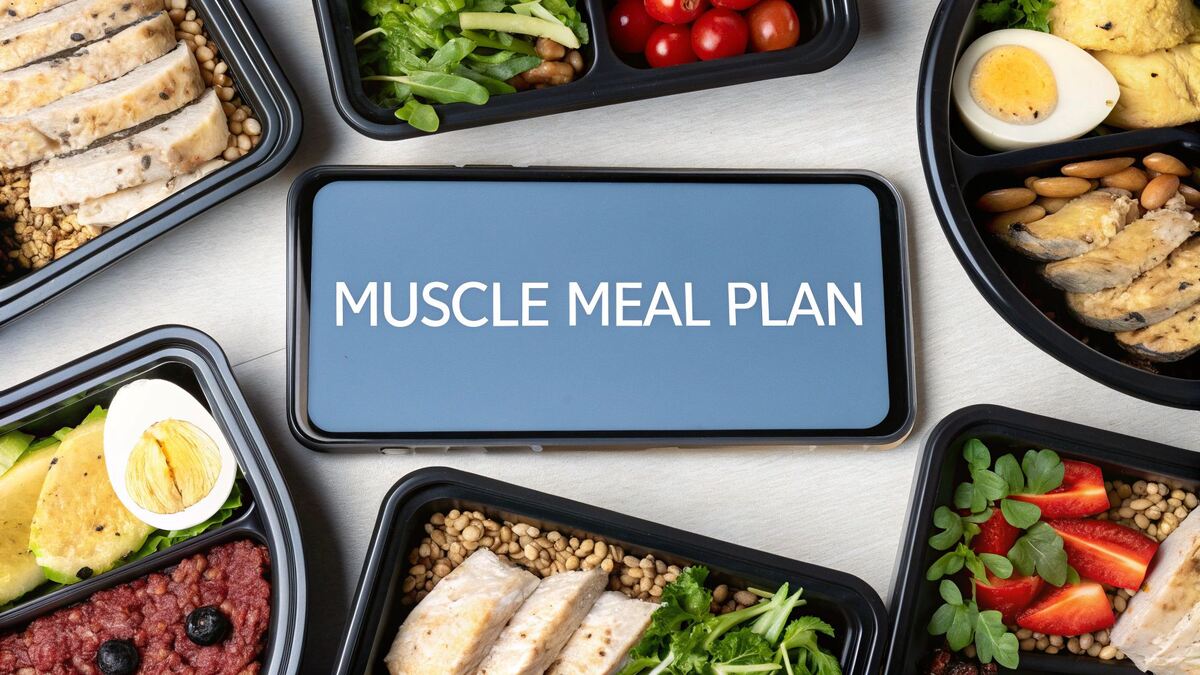A Practical Guide to Meal Planning for Muscle Gain
When it comes to building serious muscle, your work in the kitchen is just as important as your work in the gym. The whole game boils down to one simple idea: you have to consistently eat more calories than you burn, and a huge chunk of those calories needs to come from protein. This isn't about just stuffing your face; it's about creating a smart, strategic caloric surplus to give your body the fuel it needs to repair and grow.
Laying the Groundwork for Serious Muscle Growth
Before you even think about meal prep containers or grocery lists, you need to get the "why" straight. Building a powerful physique doesn't happen by accident. It’s a calculated effort that starts with a couple of non-negotiable nutritional concepts: the caloric surplus and the role of your macros. Nail these two things, and you've built the foundation for a solid plan.
The Cornerstone of Growth: A Caloric Surplus
You can have the most intense workouts in the world, but if you aren't giving your body extra energy, it simply can’t build new muscle tissue. That extra energy is your caloric surplus.
Think of it like a construction project. Your workouts are the crew, ready to work. But the calories are the truckloads of bricks, steel, and concrete. Without the materials, the crew can’t build a thing.
For muscle gain, you don't need a massive surplus. A small, controlled one is actually better. A good starting point is adding 250-500 calories on top of what you need to maintain your current weight. This gives your body enough fuel to support hypertrophy (that's the scientific term for muscle growth) without packing on a ton of unwanted body fat. Aiming for a slow, steady gain of about 0.5-1 pound per week is the sweet spot for prioritizing lean muscle.
Understanding Your Muscle-Building Team: Macros
Calories give you the raw energy, but it’s the macronutrients—protein, carbs, and fats—that tell your body what to do with it. Each one has a specific job in your muscle-building mission.
Protein (The Builder): This is the undisputed MVP. Protein is made up of amino acids, which are the literal building blocks for repairing the micro-tears that lifting creates in your muscles. No protein, no repair, no growth. It’s that simple. Think chicken, fish, lean beef, eggs, and Greek yogurt.
Carbohydrates (The Fuel): Carbs are your body's go-to energy source. They get stored in your muscles as glycogen, which is what powers you through tough training sessions. Eating enough quality carbs from sources like oats, brown rice, and sweet potatoes means you’ll have the energy to lift heavy and push for that extra rep.
Fats (The Supporter): Don't fear the fat. Healthy fats are absolutely essential for producing key hormones, including testosterone, which is a major player in muscle growth. They also keep your joints healthy and help your body absorb certain vitamins. Good sources include avocados, nuts, seeds, and olive oil.
A successful meal plan for gaining muscle isn't about some secret diet or magic food. It's about consistently applying these core principles. A smart caloric surplus and the right balance of macros create the perfect environment for your body to get bigger, stronger, and more powerful.
Alright, let's get into the nitty-gritty. Now that you understand the what and why of calories and macros, it's time to build your personal blueprint. This isn’t about grabbing some generic plan off the internet; it's about crafting daily targets that are dialed in specifically for your body and your muscle-building goals.
When you nail down your protein, carb, and fat numbers, you turn abstract nutrition concepts into a concrete roadmap for every single meal.
Start with Protein: The Cornerstone of Muscle Growth
If you're serious about gaining muscle, protein is non-negotiable. Think of it as the raw material for growth. When you lift weights, you’re essentially creating micro-tears in your muscle fibers. Protein provides the amino acids needed to patch up that damage, rebuilding the fibers bigger and stronger than before. Skimp on protein, and you're leaving gains on the table.
So, how much do you actually need? The research is pretty clear on this. For optimal muscle growth, you should be aiming for 1.6 to 2.2 grams of protein per kilogram of body weight each day. This range is consistently shown to support muscle protein synthesis.
Timing matters, too. Your body is in a catabolic (muscle-breakdown) state after a night of fasting. Kicking off your day with a high-protein breakfast—think around 30 grams—helps flip that switch back into an anabolic, muscle-building state. The U.S. Anti-Doping Agency has some great insights on this if you want to dig deeper.
Let's make this practical:
- First, get your weight in kilograms by dividing your weight in pounds by 2.2.
- Then, multiply that number by 1.6 for the low end of your range and 2.2 for the high end.
For example, a 180 lb person weighs about 82 kg. Their daily protein target would fall between 131g and 180g. My advice? If muscle gain is your main objective, stick closer to the higher end of that range.
This infographic breaks down some of the best protein sources to get you started.

As you can see, you want to build your diet around high-quality, whole-food sources like chicken, eggs, fish, and dairy. They are the bedrock of any solid muscle-building plan.
Dial in Your Fats for Hormonal Health
Next up is dietary fat, which often gets a bad rap. Healthy fats are absolutely crucial for hormone production, especially testosterone, a key player in building muscle mass. They also help your body absorb certain vitamins and just keep things running smoothly.
A solid guideline is to have fats make up 20-30% of your total daily calories. This is the sweet spot—enough to support hormonal function without taking up too much of your calorie budget from protein and carbs.
Let's go back to our 180 lb person. If we’ve figured out they need about 2,800 calories a day to build muscle:
- 2,800 calories x 0.25 (for 25%) = 700 calories from fat
- Fat contains 9 calories per gram, so: 700 / 9 = ~78g of fat per day
This amount ensures your body has what it needs for all the critical behind-the-scenes processes that support your hard work in the gym.
Remember, these numbers are your starting point, not a rigid set of rules carved in stone. Your body is unique. Pay attention to how you feel, perform, and look, and don't be afraid to make small tweaks along the way. Consistency beats perfection every time.
Fill the Rest with Carbs for Fuel
Last but not least, we fill in the rest of our calorie budget with carbohydrates. Carbs are your body's preferred energy source. They fuel your intense workouts and, just as importantly, they replenish the glycogen stores in your muscles that you deplete during training.
Once your protein and fat targets are set, the rest is simple math. We'll use the remaining calories for carbs.
Let’s finish the calculation for our example person on a 2,800-calorie plan, aiming for 180g of protein:
- Protein Calories: 180g of protein x 4 calories/gram = 720 calories
- Fat Calories: 78g of fat x 9 calories/gram = 702 calories
- Calories Left for Carbs: 2,800 (total) - 720 (protein) - 702 (fat) = 1,378 calories
- Grams of Carbs: 1,378 calories / 4 calories/gram = ~345g of carbs
And there you have it. Your personal macro blueprint: 180g protein, 345g carbs, and 78g fat. These are the numbers that will guide every meal you plan and build, turning your effort into real, measurable results.
Building Your High-Impact Grocery List

Alright, you've got your personalized macro blueprint. Now for the fun part: turning those numbers into actual, delicious food. A successful muscle-building plan truly starts at the grocery store. Forget the old-school bodybuilder trope of endless Tupperware filled with plain chicken and broccoli. We're going to stock your kitchen with a diverse arsenal of foods that not only fuel growth but also speed up recovery and, most importantly, keep you from getting bored.
The guiding principle here is simple but powerful: prioritize whole, minimally processed foods. Your body is incredibly efficient at using these. They come loaded with the micronutrients—vitamins and minerals—that do the behind-the-scenes work, supporting everything from energy production to hormone regulation. All of this is critical for building quality muscle.
Anchor Your List with Powerful Proteins
Protein is the absolute non-negotiable anchor of your grocery list. This is where you want to be strategic, aiming for both quality and variety. Different protein sources bring unique amino acid profiles and other nutrients to the table, and rotating them is a pro move.
Some of my go-to protein staples include:
- Lean Meats: Chicken breast, turkey breast, and lean cuts of beef like sirloin or 93/7 ground beef are classics for a reason. They pack a serious protein punch with minimal fat.
- Fatty Fish: Don't sleep on salmon and tuna. They're not only packed with protein but are also rich in omega-3 fatty acids, which are fantastic for fighting inflammation and helping you recover from those tough workouts.
- Eggs and Dairy: Whole eggs, Greek yogurt, and cottage cheese are incredibly versatile. You can work them into literally any meal of the day, from a morning scramble to a high-protein late-night snack.
It's not just about hitting a protein number; the quality of that protein matters immensely. For instance, a study from the University of Illinois really drove this home. Researchers found that eating whole eggs after a workout stimulated significantly more muscle protein synthesis than just consuming an equivalent amount of protein from egg whites. You can dive into the full findings on muscle building responses to whole foods to see just how much of a difference the source makes.
Fuel Your Workouts with Complex Carbs
Next up, high-quality carbohydrates. Think of these as the premium fuel for your body's engine, filling up the muscle glycogen stores that power you through intense lifting sessions. This isn't an excuse to load up on sugary junk. We're talking about complex carbs that deliver a slow, steady release of energy.
Be sure to add these to your list:
- Whole Grains: Oats, quinoa, and brown rice are fantastic staples. They’re fibrous, digest slowly, and keep your energy levels stable.
- Starchy Vegetables: Sweet potatoes, regular potatoes, and corn are dense carb sources that also come packed with vitamins and minerals like potassium, which is vital for proper muscle function.
- Legumes: Lentils and chickpeas are a great two-for-one deal, giving you both complex carbs and a respectable amount of plant-based protein.
Don't view carbs as the enemy. They are the fuel in your tank. Showing up to a heavy leg day with depleted glycogen is like trying to drive a car on an empty tank—you won’t get very far.
Incorporate Essential Healthy Fats
Finally, let's round out that shopping cart with healthy fats. They play a crucial role in supporting hormone production—including testosterone—and are essential for your overall health. Fats are also the most calorie-dense macro, which makes them an efficient way to hit your calorie surplus without feeling like you have to eat mountains of food.
Look for these high-impact sources:
- Avocados: Incredibly versatile and packed with nutrients. Add them to salads, spread on toast, or blend into a smoothie.
- Nuts and Seeds: Almonds, walnuts, chia seeds, and flax seeds are perfect for snacking or as a topping for oatmeal and yogurt.
- Oils: Extra virgin olive oil and avocado oil should be your go-to choices for cooking and making dressings.
To make things even easier, I've put together a quick-reference table of some of the best foods you can buy. Think of this as your cheat sheet for the grocery store.
High-Impact Foods for Your Muscle Gain Meal Plan
| Lean Protein Sources | Complex Carbohydrates | Healthy Fats |
|---|---|---|
| Chicken Breast | Oats (Rolled or Steel-Cut) | Avocado |
| Turkey Breast | Brown Rice | Almonds & Walnuts |
| 93/7 Lean Ground Beef | Quinoa | Chia & Flax Seeds |
| Salmon | Sweet Potatoes | Extra Virgin Olive Oil |
| Tuna | Whole-Wheat Pasta | Nut Butters |
| Eggs | Lentils & Chickpeas | Olives |
| Greek Yogurt | Ezekiel Bread | Coconut Oil |
| Cottage Cheese | Potatoes | Seeds (Pumpkin, Sunflower) |
By building your shopping list around these core categories and using this table as a guide, you're setting yourself up for success. A well-stocked kitchen is the first real, tangible step in making your meal planning for muscle gain a sustainable part of your life.
Structuring Your Meals for Maximum Anabolic Effect

Alright, you've got your macro targets dialed in and the fridge is stocked with good food. Now comes the part that really separates the amateurs from the pros: when you eat. It's not just about cramming all your food in by midnight; it's about strategically timing your meals to keep your body in a prime muscle-building state, what we call an anabolic state, for as long as possible.
Think of it like keeping a campfire roaring. You don't just dump all the wood on at once and walk away. You add logs steadily to maintain a strong, consistent flame. Your muscles need that same steady supply of fuel—specifically, amino acids from protein—to constantly repair and grow.
The Power of Consistent Protein Pacing
The best way I've found to stay anabolic is to spread protein intake evenly across the day. For years, bodybuilders have lived by the "eat every few hours" rule, and science has largely caught up to confirm this isn't just bro-science. The entire point is to prevent your muscles from ever running low on the building blocks they need.
The sweet spot seems to be spacing your protein-rich meals every 3 to 5 hours. This rhythm helps to repeatedly kickstart muscle protein synthesis (MPS), which is the actual process of building new muscle tissue. To really maximize this effect, aim for about 0.3 grams of high-quality protein per kilogram of your body weight in each of those meals. This is a strategy that's been validated in findings about optimal protein distribution.
Don't panic—this doesn't mean you need to live by a stopwatch and eat six times a day. For most of us, a schedule of 4-5 well-planned meals (and that includes snacks) is perfectly practical and incredibly effective.
Your Anabolic Kickstart: The High-Protein Breakfast
After sleeping all night, your body is naturally in a catabolic (muscle-breakdown) state. Your very first meal is your chance to slam the brakes on that process and flip the switch back to muscle-building mode. This is why a breakfast packed with protein is non-negotiable.
Starting your day with a carb-bomb like a sugary cereal or a plain bagel does next to nothing for your goals. You need to prioritize a breakfast that delivers a solid hit of at least 30 grams of protein.
Here are some simple but powerful swaps I recommend:
- Instead of: A bowl of sweetened cereal.
- Try: Greek yogurt mixed with a scoop of protein powder, topped with some berries and almonds.
- Instead of: A plain croissant or muffin.
- Try: A three-egg omelet loaded with spinach, with a side of whole-grain toast and avocado.
This one change sets a powerful anabolic tone for the rest of your day.
The most overlooked aspect of nutrition for muscle gain isn't some secret supplement; it's consistency. Timing your meals to deliver a steady stream of protein is what separates moderate progress from exceptional results.
Fueling Performance and Recovery Around Your Workout
The meals you eat before and after you train are your biggest leverage points for boosting performance and recovery. People love to talk about the "anabolic window," and while the idea of a strict 30-minute deadline is a bit overblown, the principle is solid: what you eat around your workout matters.
Pre-Workout Meal (1-2 hours before training): The goal here is to top off your energy stores and give your muscles an early supply of amino acids. You want a meal that’s mainly complex carbs with a decent amount of protein. The carbs fuel your workout, and the protein helps prevent muscle breakdown while you're lifting.
- A classic example: A bowl of oatmeal with a scoop of protein powder and a banana.
Post-Workout Meal (Within 1-2 hours after training): Now, the focus shifts entirely to recovery and repair. Your body is screaming for fast-digesting carbs to replenish the glycogen you just burned and high-quality protein to start rebuilding damaged muscle fibers.
- My go-to: A whey protein shake with a piece of fruit right after the gym, followed by a real meal like grilled chicken and white rice about an hour later.
By putting a little thought into these two key meals, you give your body everything it needs not just to get through a tough workout, but to come back stronger.
Mastering Meal Prep for Unstoppable Consistency
Let's be honest, you can have the perfect workout plan, but if your nutrition isn't dialed in, your gains will stall. Consistent meal prep is the single biggest factor that separates those who see incredible results from those who just spin their wheels. It's what turns a loose eating routine into a reliable muscle-building machine.
When you take the time to chop, cook, and portion your meals ahead of time, you completely sidestep the temptation to grab whatever's convenient. No more derailing your progress with fast food just because you’re starving after a brutal leg day. You’ll always have a high-protein, macro-friendly meal waiting for you.
Getting Your Kitchen Set Up
You don't need a professional chef's kitchen to make meal prep work. A few key pieces of gear will make the entire process faster, easier, and a lot less of a chore.
- Quality Containers: I prefer glass, but BPA-free plastic works too. The key is getting containers that stack well and are the right size for your portions.
- Digital Kitchen Scale: This is non-negotiable. "Eyeballing it" is a recipe for missed macro targets. Accuracy is everything when you're serious about results.
- A Slow Cooker or Instant Pot: These are game-changers. You can set it and forget it, batch-cooking large amounts of shredded chicken or beef with almost zero effort.
- A Good Knife and Cutting Board: Don't underestimate how much a sharp knife can speed up your prep time for veggies and protein.
Investing in these basics will save you hours every single week. That's more time and mental energy you can pour into your training.
My Go-To Batch Cooking Strategies
Batch cooking is the heart and soul of effective meal prep. The idea is simple: cook large quantities of staple foods in one session, then mix and match them for your meals throughout the week.
Here’s how I typically approach it on a Sunday afternoon:
- Pick Your Proteins: I’ll grill up a big batch of chicken breasts or brown a few pounds of lean ground turkey.
- Roast the Veggies: A huge sheet pan of broccoli, bell peppers, and onions tossed in a little olive oil and seasoning is an easy way to get your micronutrients in.
- Cook Your Carbs: While everything else is cooking, I'll get a large pot of rice or quinoa going on the stove.
- Portion Everything Out: Once it's all cooked and cooled, I line up my containers and start building my meals for the next few days.
- Use Your Freezer: If I’ve made more than enough for 4-5 days, I'll freeze a few portions. This keeps them fresh and gives me an emergency meal for later in the week.
Sample Muscle Gain Meal Plan (2800 Calories)
To give you a clearer picture of how this all comes together, here’s a practical one-day example. This is built around a 2800-calorie target, which is a common starting point for many men looking to build muscle. You can easily adjust the portion sizes up or down to fit your own specific calorie and macro needs.
| Meal | Food Items | Approx. Protein (g) | Approx. Carbs (g) | Approx. Fat (g) |
|---|---|---|---|---|
| Breakfast | Omelet (4 egg whites, 1 whole egg), 1 cup oatmeal, 1/2 cup berries | 30 | 55 | 12 |
| Lunch | 6oz grilled chicken breast, 1.5 cups brown rice, 1 cup broccoli | 45 | 65 | 8 |
| Snack | 1 cup Greek yogurt, 1 banana, 1oz almonds | 25 | 40 | 15 |
| Dinner | 6oz baked salmon, 1 large sweet potato, 1 cup asparagus spears | 40 | 45 | 20 |
| Post-Workout | 1 scoop whey protein shake with water, 1 apple | 25 | 25 | 2 |
This is just a template. Feel free to swap chicken for turkey, rice for quinoa, or salmon for lean steak. The goal is to hit your numbers with foods you actually enjoy eating.
Storing And Reheating For The Best Taste
Don't let your hard work go to waste with soggy, bland meals. Proper storage is key to keeping your food tasting fresh. I find glass containers with airtight lids do the best job.
- Always label each container with the contents and the date you made it.
- To avoid sad, watery meals, store sauces and dressings separately in small containers.
- If you’ve frozen a meal, pull it out the night before and let it thaw in the fridge. It will reheat much more evenly.
Most meals can be ready in a couple of minutes in the microwave, but if you have an extra five minutes, reheating proteins and veggies in a hot skillet makes a world of difference.
A Simple Weekly Prep Rhythm
Finding a rhythm that works for you is what makes this a sustainable habit. You don't need a rigid, military-style schedule, but a loose structure prevents things from falling through the cracks.
- Sunday: This is my big day. I do my grocery shopping and then spend an hour or two cooking my core proteins, carbs, and veggies for the week.
- Wednesday: I'll do a quick "mid-week restock." This might mean grilling a couple more chicken breasts or cooking another batch of rice to get me through to the weekend.
- Friday: I take a quick inventory of what’s left, freeze any extras, and start jotting down ideas for next week’s menu.
This simple flow helps me stay ahead of the game, so I'm never left scrambling for a meal.
"Having meals prepped is like securing a personal nutritionist 24/7. It removes excuses and fuels real results." - Coach Jamie Nguyen
From my own experience, this kind of flexible schedule is what prevents burnout. It allows for life to happen—a spontaneous dinner out or a late night at work—without completely derailing my progress.
If you want a hand in automating the planning part, tools like the AI Meal Planner can generate menus and shopping lists based on your macros, which can be a huge time-saver.
Tips For Lightning-Fast Meal Assembly
Sometimes, even with food prepped, you're just in a rush. Having a few tricks up your sleeve for near-instant meals is crucial.
- Lean on ready-to-eat proteins. A can of tuna, a rotisserie chicken from the grocery store, or some quality jerky can be a lifesaver.
- Throw pre-cooked grains and frozen veggies into a skillet with a splash of soy sauce for a five-minute stir-fry.
- Keep macro-friendly snacks like protein bars, individual packs of nuts, and rice cakes on hand for those moments when you need a quick energy boost.
Mastering meal planning for muscle gain isn't about being perfect; it's about being prepared. Stick with it, and you’ll find that solid nutrition becomes second nature, freeing you up to focus on what matters most: getting stronger in the gym.
Got Questions About Eating for Muscle? I've Got Answers.
Even with the best plan laid out, you're going to have questions. It’s completely normal to hit a few sticking points or feel uncertain when you’re overhauling your diet. This is where we clear up some of that confusion.
Think of this as your personal troubleshooting guide for the most common hurdles people face when trying to eat for muscle growth. Let's get straight to the questions I hear all the time.
How Long Until I Actually See Results?
This is the big one, isn't it? Everyone wants to know when the hard work will start to show. The honest answer is that real, sustainable muscle growth is a marathon, not a sprint. You have to be patient and, more than anything, consistent.
You'll almost certainly feel the results before you see them. That feeling of getting stronger in the gym can happen within a few weeks. As for actually seeing more muscle in the mirror? Give it a solid 8-12 weeks of consistent training and nutrition. Just remember, everyone's body is different—your genetics, how long you've been training, and even how well you sleep will all impact your timeline.
Are Protein Shakes and Supplements a Must?
It's a common myth that you need a cupboard full of powders and pills to build muscle. Let's clear this up: supplements are not mandatory. The foundation of your diet should always be whole foods. Period.
That said, supplements like whey or casein protein can be incredibly convenient. Struggling to hit your protein target for the day? A shake is an easy fix. Rushing out after a workout? It’s a fast way to get protein in and start the recovery process.
Think of supplements as tools to help you fill the gaps. They support a good diet; they don't replace it. Your first priority is always hitting your calorie and protein goals with real, nutrient-dense food.
What if I Miss a Meal or Totally Blow My Diet?
First, take a breath. One missed meal or one night of pizza won't wreck your progress. The biggest mistake you can make is falling into an all-or-nothing trap, where one slip-up makes you want to quit altogether.
Life gets in the way. It happens.
If you miss a meal, just get back on track with your next one. Don't try to stuff yourself to make up for it. If you overeat, don't punish yourself with extra cardio or by skipping your next meal. Just acknowledge it happened and get back to your plan. Consistency over the long haul is what matters, not perfection on a single day.
Can I Still Eat at Restaurants?
Of course! A good nutrition plan should fit into your life, not force you to become a hermit. You can absolutely enjoy eating out without sabotaging your goals. It just takes a little planning.
Here are a few simple strategies I use:
- Do some recon: Check the menu online before you go. You can pick out a solid, protein-focused option without being put on the spot.
- Build around protein: Look for grilled chicken, fish, steak, or other lean protein sources and make that the star of your plate.
- Sauce on the side: This is a game-changer. Asking for dressings, sauces, or gravies on the side lets you control how much you're actually using.
- Make smart swaps: Most places are happy to make substitutions. Ask to switch out fries for steamed vegetables or a baked potato. It's an easy win.
Learning how to navigate a restaurant menu is a skill. Once you master it, you’ll have the freedom to stay on track while still living your life.
Ready to stop guessing and start building a meal plan that truly works for you? The AI Meal Planner takes the complexity out of nutrition by generating personalized weekly menus based on your specific muscle gain goals, dietary needs, and food preferences. Get your custom plan and start fueling your growth today. Discover your personalized meal plan now.
AI-powered nutrition
Get Your Personalized Meal Plan
AI creates the perfect meals for your goals, lifestyle, and taste.
Start Your Journej
